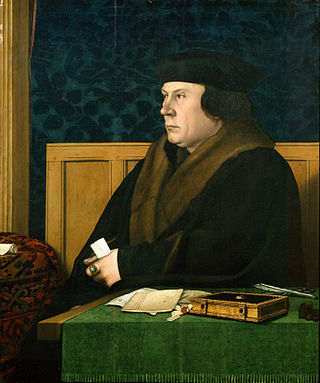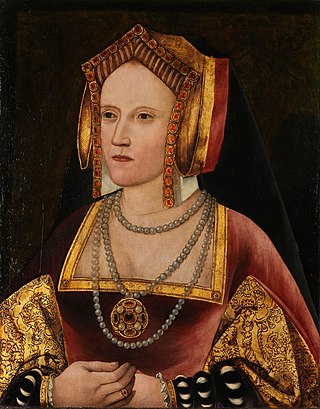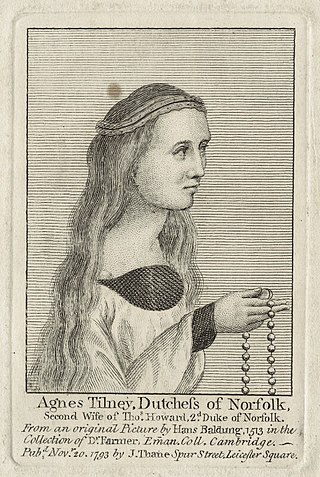Related Research Articles

Catherine of Aragon was Queen of England as the first wife of King Henry VIII from their marriage on 11 June 1509 until their annulment on 23 May 1533. Born in Spain, she was Princess of Wales while married to Henry's elder brother, Arthur, Prince of Wales, for a short period before his death.

Henry VIII was King of England from 22 April 1509 until his death in 1547. Henry is best known for his six marriages, and for his efforts to have his first marriage annulled. His disagreement with Pope Clement VII about such an annulment led Henry to initiate the English Reformation, separating the Church of England from papal authority. He appointed himself Supreme Head of the Church of England and dissolved convents and monasteries, for which he was excommunicated by the pope. Henry is also known as the "father of the Royal Navy" as he invested heavily in the English fleet, establishing a standing navy which he expanded from seven to some fifty ships over his lifetime, and developed its command structure.

Anne Boleyn was Queen of England from 1533 to 1536, as the second wife of King Henry VIII. The circumstances of her marriage and of her execution by beheading for treason and other charges made her a key figure in the political and religious upheaval that marked the start of the English Reformation. Anne was the daughter of Thomas Boleyn, 1st Earl of Wiltshire, and his wife, Elizabeth Howard, and was educated in the Netherlands and France, largely as a maid of honour to Queen Claude of France. Anne returned to England in early 1522, to marry her Irish cousin James Butler, 9th Earl of Ormond; the marriage plans were broken off, and instead, she secured a post at court as maid of honour to Henry VIII's wife, Catherine of Aragon.

Thomas Cromwell, briefly Earl of Essex, was an English lawyer and statesman who served as chief minister to King Henry VIII from 1534 to 1540, when he was beheaded on orders of the king, who later blamed false charges for the execution.

Margaret Plantagenet, Countess of Salisbury, also called Margaret Pole, as a result of her marriage to Sir Richard Pole, was the only surviving daughter of George Plantagenet, Duke of Clarence, a brother of Kings Edward IV and Richard III, by his wife Isabel Neville. Margaret was one of just two women in 16th-century England to be a peeress in her own right without a husband in the House of Lords. As one of the few members of the House of Plantagenet to have survived the Wars of the Roses, she was executed in 1541 at the command of King Henry VIII, the second monarch of the House of Tudor, who was the son of her first cousin, Elizabeth of York. Pope Leo XIII beatified her as a martyr for the Roman Catholic Church on 29 December 1886.

Thomas Howard, 3rd Duke of Norfolk, was a prominent English politician and nobleman of the Tudor era. He was an uncle of two of the wives of King Henry VIII, Anne Boleyn and Catherine Howard, both of whom were beheaded, and played a major role in the machinations affecting these royal marriages. After falling from favour in 1546, he was stripped of his Dukedom and imprisoned in the Tower of London, avoiding execution when Henry VIII died on 28 January 1547.

Elizabeth Barton, known as "The Nun of Kent", "The Holy Maid of London", "The Holy Maid of Kent" and later "The Mad Maid of Kent", was an English Catholic nun. She was executed as a result of her prophecies against the marriage of King Henry VIII of England to Anne Boleyn.

In common parlance, the wives of Henry VIII were the six queen consorts of King Henry VIII of England between 1509 and his death in 1547. In legal terms, Henry had only three wives, because three of his marriages were annulled by the Church of England. However, he was never granted an annulment by the Pope, as he desired, for Catherine of Aragon, his first wife. Annulments declare that a true marriage never took place, unlike a divorce, in which a married couple end their union. Along with his six wives, Henry took several mistresses.
Bishop Rowland Lee was an English clergyman who served as Bishop of Coventry and Lichfield 1534–43 and also as Lord President of the Marches under King Henry VIII.

Agnes Howard was the second wife of Thomas Howard, 2nd Duke of Norfolk. Two of King Henry VIII's queens were her step-granddaughters, Anne Boleyn and Katherine Howard. Catherine Howard was placed in the Dowager Duchess's care after her mother's death.
Events from the 1530s in England.
Events from the 1500s in England.
Richard Risby, O.F.M., was an English Catholic Franciscan friar who was executed for treason during the reign of King Henry VIII.

John Forest was an English Franciscan friar and martyr. Confessor to Queen Catherine of Aragon, Forest was burned to death at Smithfield for heresy, in that he refused to acknowledge the King as head of the church.
Edward Powell was a Welsh Roman Catholic priest and theologian, in opposition to Henry VIII of England. He is a Catholic martyr, beatified in 1886.
Anne Berkeley, Baroness Berkeley was a lady-in-waiting and companion of Queen Anne Boleyn, the second wife of Henry VIII of England. She was reputed to be one of the witnesses at the secret wedding ceremony of the King and Anne Boleyn which occurred on 25 January 1533.
Lady Elizabeth Stafford was an English aristocrat. She was the eldest daughter of Edward Stafford, 3rd Duke of Buckingham and Lady Eleanor Percy. By marriage she became Duchess of Norfolk. Her abusive marriage to Thomas Howard, 3rd Duke of Norfolk, created a public scandal.
Sir Edward Neville was an English courtier. He was born at Abergavenny, Monmouthshire. He was the son of George Neville, 4th Baron Bergavenny and his wife Margaret, daughter of Hugh Fenn. He married Eleanor Windsor, daughter of Andrew Windsor, 1st Baron Windsor and Elizabeth Blount, before 6 April 1529. He was the brother of George Nevill, 5th Baron Bergavenny and the two of them became close to King Henry VIII and the Queen, Catherine of Aragon.
Thomas Bedyll (died 1537) was a divine and royal servant. He was royal chaplain and clerk of the Privy Council of Henry VIII, assisting him with the separation from Rome.

The coronation of Anne Boleyn as Queen of England took place at Westminster Abbey, London, England, on 1 June 1533. The new queen was King Henry VIII's second wife, following the annulment of his first marriage to Catherine of Aragon.
References
- ↑ "Bocking, Edward (d. 1534)", Encyclopedia of Tudor England, Vol. 1, (John A. Wagner, Susan Walters Schmid, eds.), ABC-CLIO, 2012, ISBN 9781598842982
- 1 2 3 4 Alston, George Cyprian. "Edward Bocking." The Catholic Encyclopedia Vol. 2. New York: Robert Appleton Company, 1907. 15 August 2018
- 1 2 Lee, Sidney. "Bocking", The Dictionary of National Biography, Vol. 2, (Leslie Stephen/George Smith, eds.), Oxford University Press, 1959, p. 750
- 1 2 3 Gasquet, Francis Aidan. Henry VIII and the English Monasteries, G. Bell, 1906, p. 40
 This article incorporates text from this source, which is in the public domain .
This article incorporates text from this source, which is in the public domain . - ↑ Shagan, Ethan (2004). "Oxford Dictionary of National Biography". Oxford Dictionary of National Biography (online ed.). Oxford University Press. doi:10.1093/ref:odnb/2746.(Subscription or UK public library membership required.)
![]() This article incorporates text from a publication now in the public domain : Herbermann, Charles, ed. (1913). "Edward Bocking". Catholic Encyclopedia . New York: Robert Appleton Company.
This article incorporates text from a publication now in the public domain : Herbermann, Charles, ed. (1913). "Edward Bocking". Catholic Encyclopedia . New York: Robert Appleton Company.